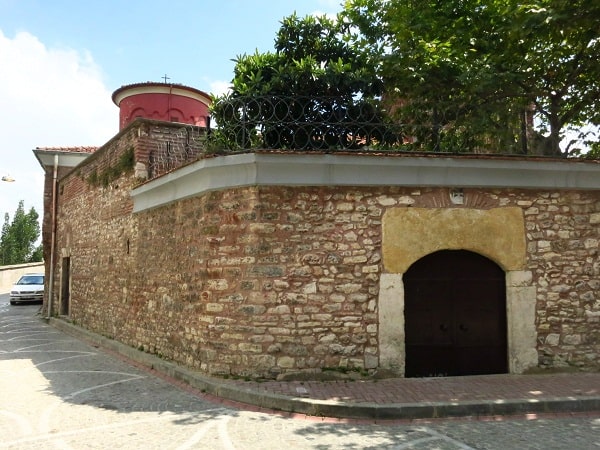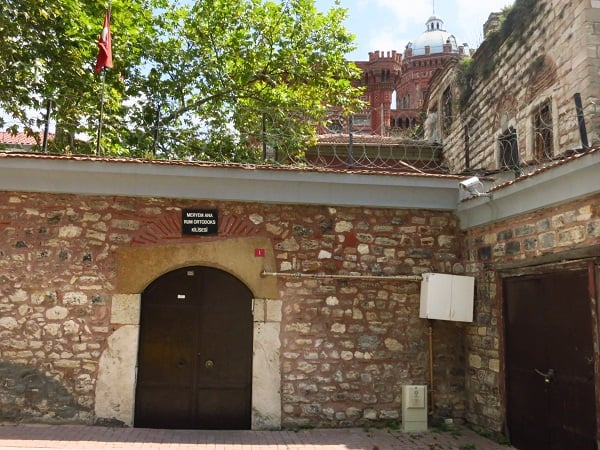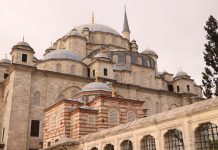Nowadays Istanbul is known for its mosques, but prior to 1453, Constantinople was a completely Christian city replete with churches. Many of them exist to this day: Hagia Sofia and Chora Church are the most renowned examples, but there is also Hagia Irene, Küçük Aya Sofya, Fethiye Mosque… In all there are some 40 Byzantine-era church structures still standing throughout the city.

However, no matter which one you visit, one feature in particular strikes the visitor: they all either have minarets, or a ticket box, or both. Astonishingly, of the dozens of extant Byzantine churches in Istanbul, only one of them has never been converted into a mosque or museum and has been in continuous service as a place of Christian worship since before the conquest of Istanbul. This is Church of St. Mary of the Mongols, a.k.a. Kanlı Kilesesi, a.k.a. Meryem Ana Greek Orthodox Church.
St. Mary of the Mongols is located in the Fener neighborhood overlooking the Golden Horn. You could be forgiven for passing it by on your last visit to the area–the church is right next to the attention-grabbing Phanar Greek Orthodox College. Like the college, St. Mary’s facade is bright scarlet, and the church’s history is as colorful as its exterior. It gained its name from its founder, Maria Palaeologina, who was the daughter of a Byzantine emperor and wedded to a Khan of the Mongol Empire. Later, during the battle for Constantinople, the church acquired another nickname — Kanlı Kilesesi or “Bloody Church,” commemorating the last desperate battles between Byzantine and Turkish forces that happened nearby.
Eventually, as a reward to the Greek architect who built Fatih Mosque, Sultan Mehmet II issued an imperial edict to prevent St. Mary of the Mongols from being converted into a mosque. In the ensuing 600 years, St. Mary has fended off additional conversion attempts and gone through a myriad of devastations and transformations — but has in some form always existed in that spot since its inception.

Today, Meryem Ana is obscured behind an imposing wall, but in fact is open to visitors. Ring the doorbell at the threshold on Firketeci Sokak — where the sign “Meryem Ana Rum Ortodoks Kilesesi” is posted — and an attendant will escort you inside the premises. Once inside the walls, it is much easier to see the church’s steeple and other architectural aspects. Inside the church are visibly ancient frescoes, dozens of ancient icons, and a variety of devotional objects of sorts I’ve never seen before, such as a nativity scene inside a bottle, and a clever slatted icon that changes its image depending on the direction it is looked at. Also framed on the wall are copies of the signed imperial firman from Fatih Mehmet that originally preserved the church from conversion.
Most interestingly, underneath the main floor of the church is an underground chamber made of stone, which you can descend into. According to the attendant, a young woman from Hatay whose family has been Christian for generations, the chamber used to be part of an underground passage that at one time connected St. Mary of the Mongols to Hagia Sofia, several kilometers away. Whether or that is true, St. Mary of the Mongols is truly “the last Byzantine church” and a living piece of history.
Hours: The church holds Sunday services and is open to visitors until 5pm.
Address: Balat Mah. Tevfiki Cafer Mahallesi Firketeci Sokak No. 5, Fener.
Directions: Take the 55T bus from Taksim. Disembark in Fener. Walk uphill along Sancaktar Yokuşu until you reach Fener Rum Lisesi. Follow Mesnevihane Sokak around the back of the college. Meryem Ana Kilesesi will be visible on your left.
Cassondra loves swingsets, art, and finding hidden historical gems. She writes about Istanbul, travel, language, and teaching at Pulsations.











I cannot wait to visit on my next trip to Istanbul.
[…] In a city rich with historical and cultural attractions, the Church of St. Mary of the Mongols is a quieter venue. It is not frequented by tourists as are many other historical structures of the city. And yet, this quiet church behind its wall is an arresting view. Its captivating history has infused its present atmosphere; it is a remarkable attraction that should not be missed on a visit to Istanbul. […]